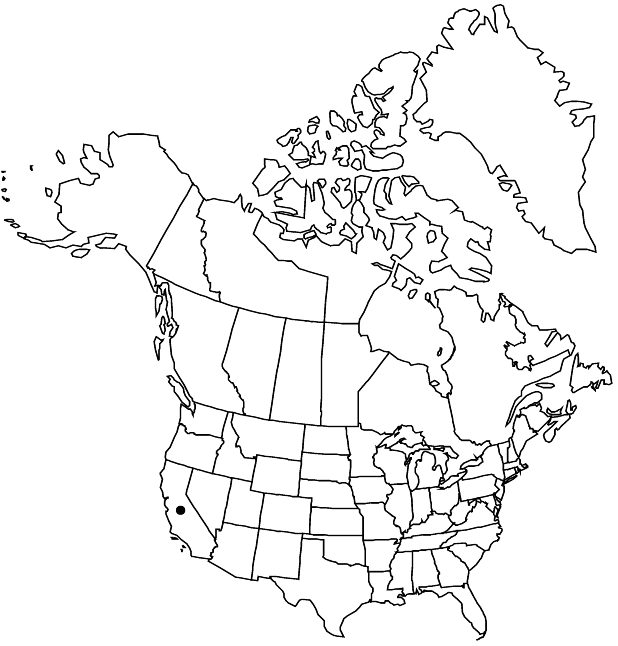Difference between revisions of "Ribes californicum"
Bot. Beechey Voy., 346. 1839 ,.
FNA>Volume Importer |
imported>Volume Importer |
||
| (6 intermediate revisions by 2 users not shown) | |||
| Line 7: | Line 7: | ||
}} | }} | ||
|common_names=Hillside gooseberry | |common_names=Hillside gooseberry | ||
| + | |special_status={{Treatment/ID/Special_status | ||
| + | |code=E | ||
| + | |label=Endemic | ||
| + | }} | ||
|basionyms= | |basionyms= | ||
|synonyms={{Treatment/ID/Synonym | |synonyms={{Treatment/ID/Synonym | ||
|name=Grossularia californica | |name=Grossularia californica | ||
|authority=(Hooker & Arnott) Coville & Britton | |authority=(Hooker & Arnott) Coville & Britton | ||
| + | |rank=species | ||
}} | }} | ||
|hierarchy=Grossulariaceae;Ribes;Ribes californicum | |hierarchy=Grossulariaceae;Ribes;Ribes californicum | ||
| Line 24: | Line 29: | ||
|distribution=Calif. | |distribution=Calif. | ||
|discussion=<p>Varieties 2 (2 in the flora).</p><!-- | |discussion=<p>Varieties 2 (2 in the flora).</p><!-- | ||
| − | --><p>Ribes amarum, R. binominatum, R. californicum, R. lobbii, R. menziesii, R. roezlii, and R. speciosum formed a clade sister to R. velutinum in the analyses of L. M. Schultheis and M. J. Donoghue (2004). These western taxa have stamens with relatively long filaments and anthers that are short-apiculate with indehiscent tips, and most have deep red or pink, reflexed sepals and erect, mostly white petals that form a tube. Based on these morphologic characters, R. marshallii, R. thacherianum, and R. victoris Janczewski also belong here. Taxa have been recognized at specific, subspecific, or varietal level within this striking group; the entire complex requires more study.</p><!-- | + | --><p><i>Ribes amarum</i>, <i>R. binominatum</i>, <i>R. californicum</i>, <i>R. lobbii</i>, <i>R. menziesii</i>, <i>R. roezlii</i>, and <i>R. speciosum</i> formed a clade sister to <i>R. velutinum</i> in the analyses of L. M. Schultheis and M. J. Donoghue (2004). These western taxa have stamens with relatively long filaments and anthers that are short-apiculate with indehiscent tips, and most have deep red or pink, reflexed sepals and erect, mostly white petals that form a tube. Based on these morphologic characters, <i>R. marshallii</i>, <i>R. thacherianum</i>, and <i>R. victoris</i> Janczewski also belong here. Taxa have been recognized at specific, subspecific, or varietal level within this striking group; the entire complex requires more study.</p><!-- |
| − | --><p>Ribes californicum occurs in the Coast Ranges from Mendocino County to the Santa Ana and San Gabriel Mountains.</p> | + | --><p><i>Ribes californicum</i> occurs in the Coast Ranges from Mendocino County to the Santa Ana and San Gabriel Mountains.</p> |
|tables= | |tables= | ||
|references= | |references= | ||
| Line 48: | Line 53: | ||
-->{{#Taxon: | -->{{#Taxon: | ||
name=Ribes californicum | name=Ribes californicum | ||
| − | |||
|authority=Hooker & Arnott | |authority=Hooker & Arnott | ||
|rank=species | |rank=species | ||
| Line 59: | Line 63: | ||
|publication title=Bot. Beechey Voy., | |publication title=Bot. Beechey Voy., | ||
|publication year= | |publication year= | ||
| − | |special status= | + | |special status=Endemic |
| − | |source xml=https:// | + | |source xml=https://bitbucket.org/aafc-mbb/fna-data-curation/src/2e0870ddd59836b60bcf96646a41e87ea5a5943a/coarse_grained_fna_xml/V8/V8_48.xml |
|genus=Ribes | |genus=Ribes | ||
|species=Ribes californicum | |species=Ribes californicum | ||
Latest revision as of 22:44, 5 November 2020
Plants 0.6–1.4 m. Stems erect, glabrous; spines at nodes 3, 5–15 mm; prickles on internodes absent. Leaves: petiole ca. 0.5 cm, tomentose; blade roundish, shallowly 3(–5)-lobed, cleft nearly 1/4 to midrib, 1–3 cm, base truncate, surfaces glabrous, glabrate, or hairy, not glandular, lobes broadly oblong, sides parallel, margins with 2–4 blunt teeth, apex rounded. Inflorescences ascending, solitary flowers or 2–3-flowered racemes, 1.5–4 cm, axis glabrous or with few stipitate glands, flowers evenly spaced. Pedicels not jointed, 6–8 mm, pubescent, sparsely stipitate-glandular; bracts broadly ovate, 3–5 mm, glabrous or sparsely hairy. Flowers: hypanthium greenish, broadly tubular, 2 mm, glabrous or puberulent; sepals not overlapping, reflexed, dark red or green tinged with dark red, deltate-ovate, 6–8 mm; petals connivent, erect, white, oblong, inrolled, 2–4 mm; nectary disc not prominent; stamens 0.9–4 times as long as petals, sometimes slightly shorter or longer than petals; filaments linear, 6–8 mm, glabrous; anthers greenish yellow, lanceolate, somewhat sagittate, 1.8–2 mm, apex apiculate; ovary with longer, glandless bristles among gland-tipped hairs; styles connate nearly to middle, 8–10 mm, glabrous. Berries palatable, red, globose, 9–10 mm, bristles stiff, glandular and eglandular.
Discussion
Varieties 2 (2 in the flora).
Ribes amarum, R. binominatum, R. californicum, R. lobbii, R. menziesii, R. roezlii, and R. speciosum formed a clade sister to R. velutinum in the analyses of L. M. Schultheis and M. J. Donoghue (2004). These western taxa have stamens with relatively long filaments and anthers that are short-apiculate with indehiscent tips, and most have deep red or pink, reflexed sepals and erect, mostly white petals that form a tube. Based on these morphologic characters, R. marshallii, R. thacherianum, and R. victoris Janczewski also belong here. Taxa have been recognized at specific, subspecific, or varietal level within this striking group; the entire complex requires more study.
Ribes californicum occurs in the Coast Ranges from Mendocino County to the Santa Ana and San Gabriel Mountains.
Selected References
None.
Key
| 1 | Leaf blades glabrous or glabrate; stamens 2-4 times as long as petals. | Ribes californicum var. californicum |
| 1 | Leaf blades hairy; stamens 0.9-1 times as long as petals. | Ribes californicum var. hesperium |
